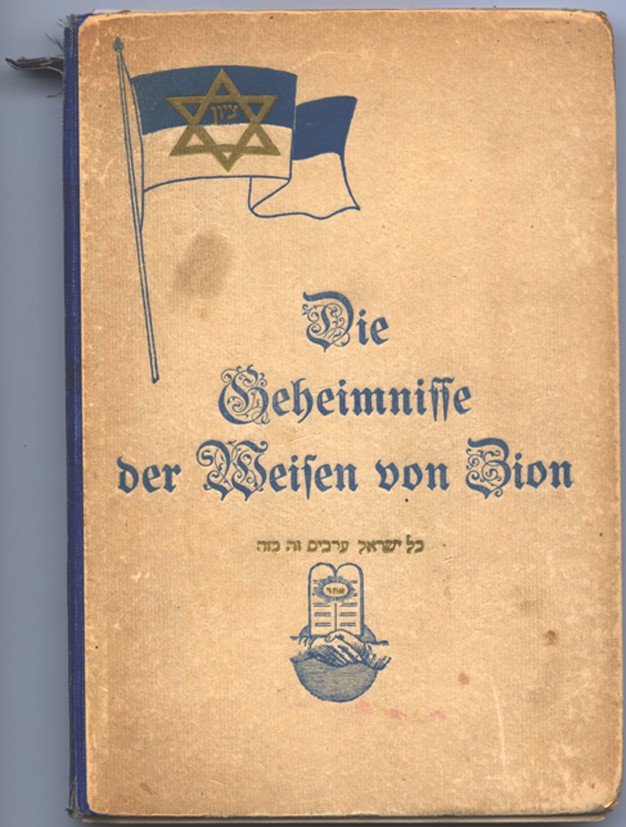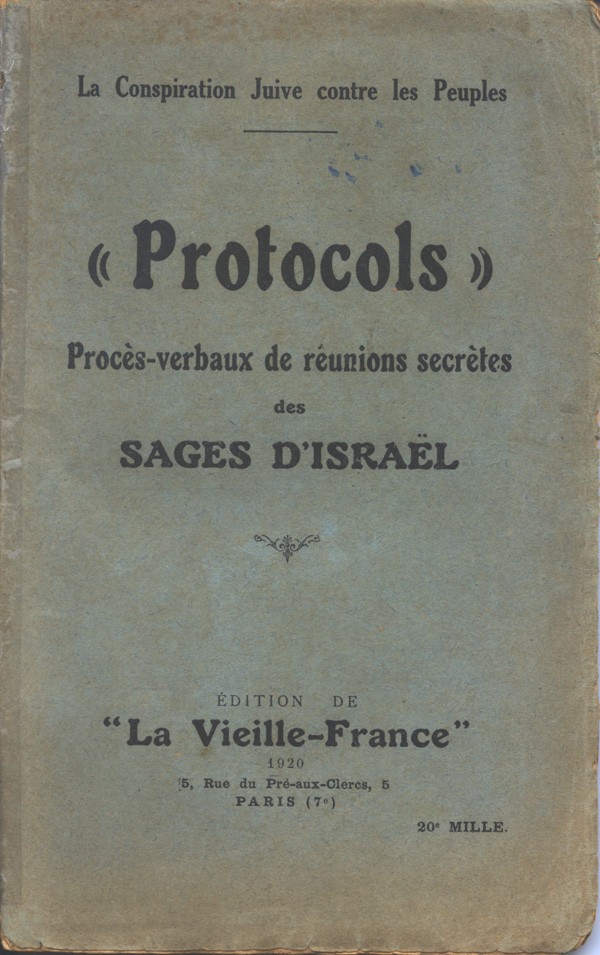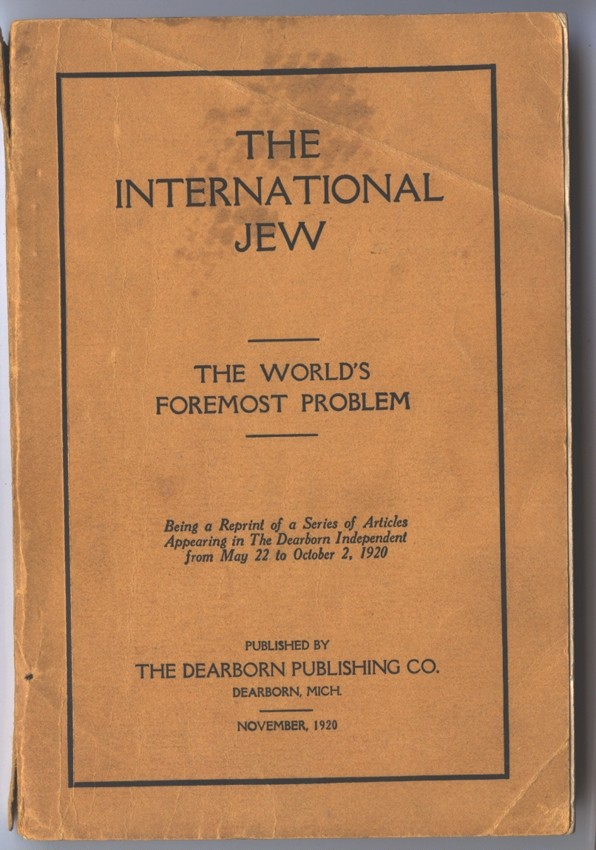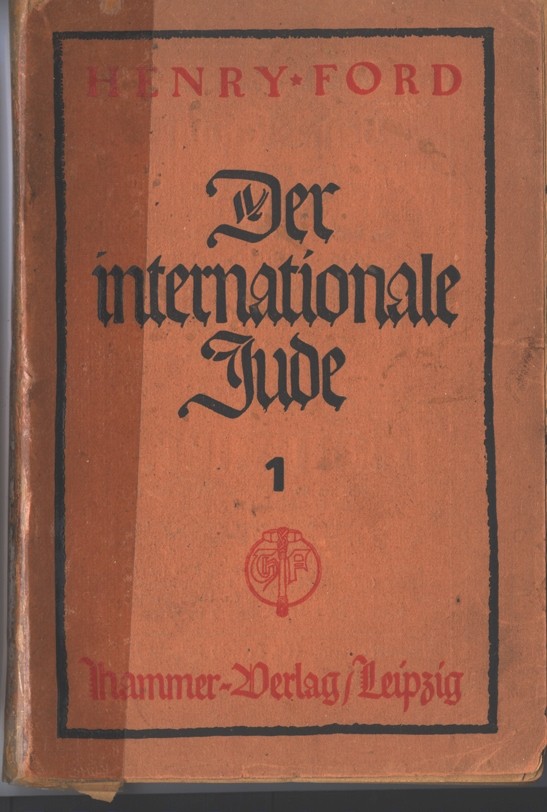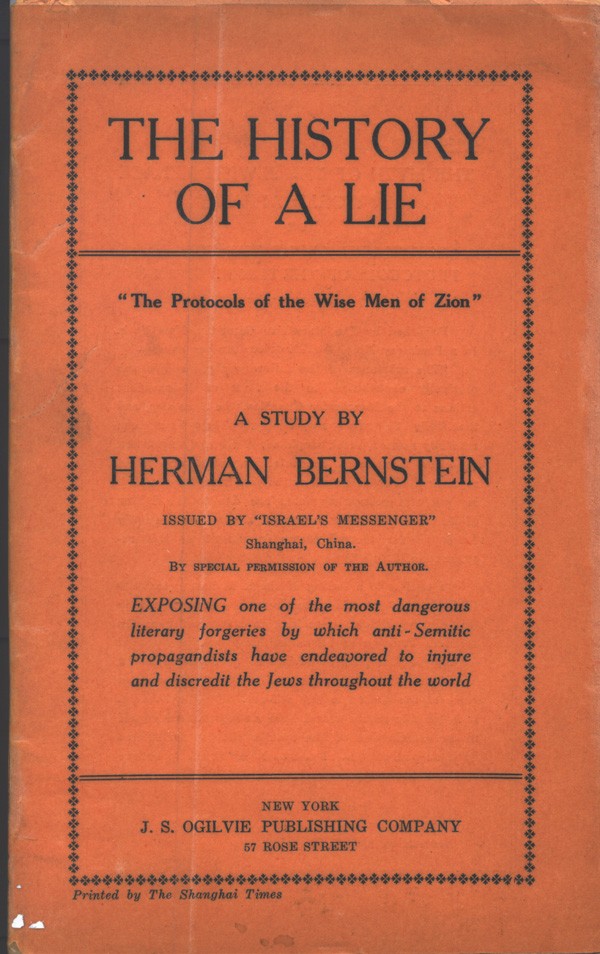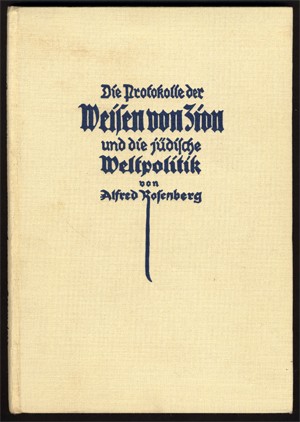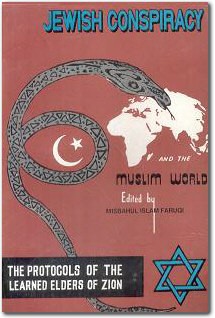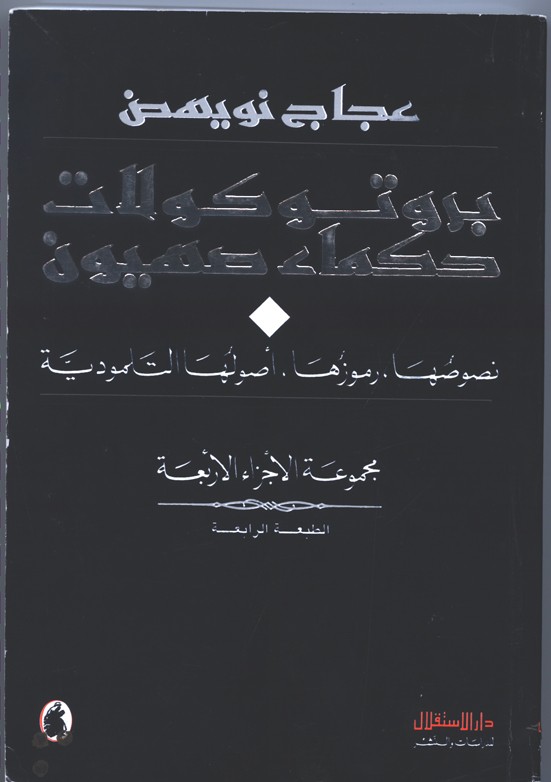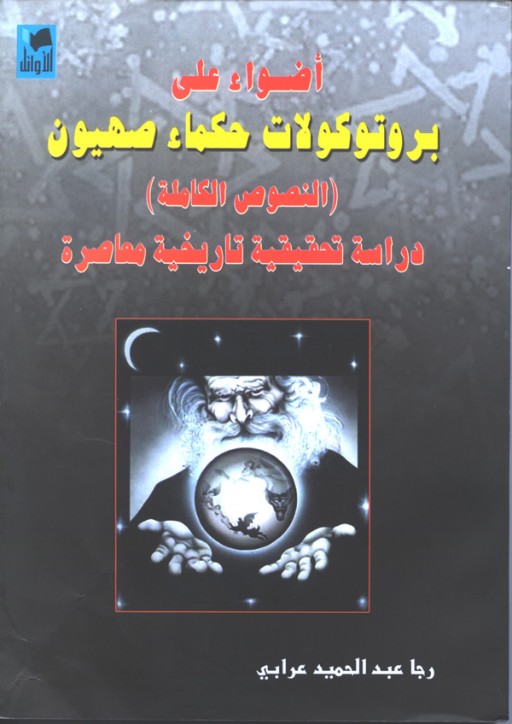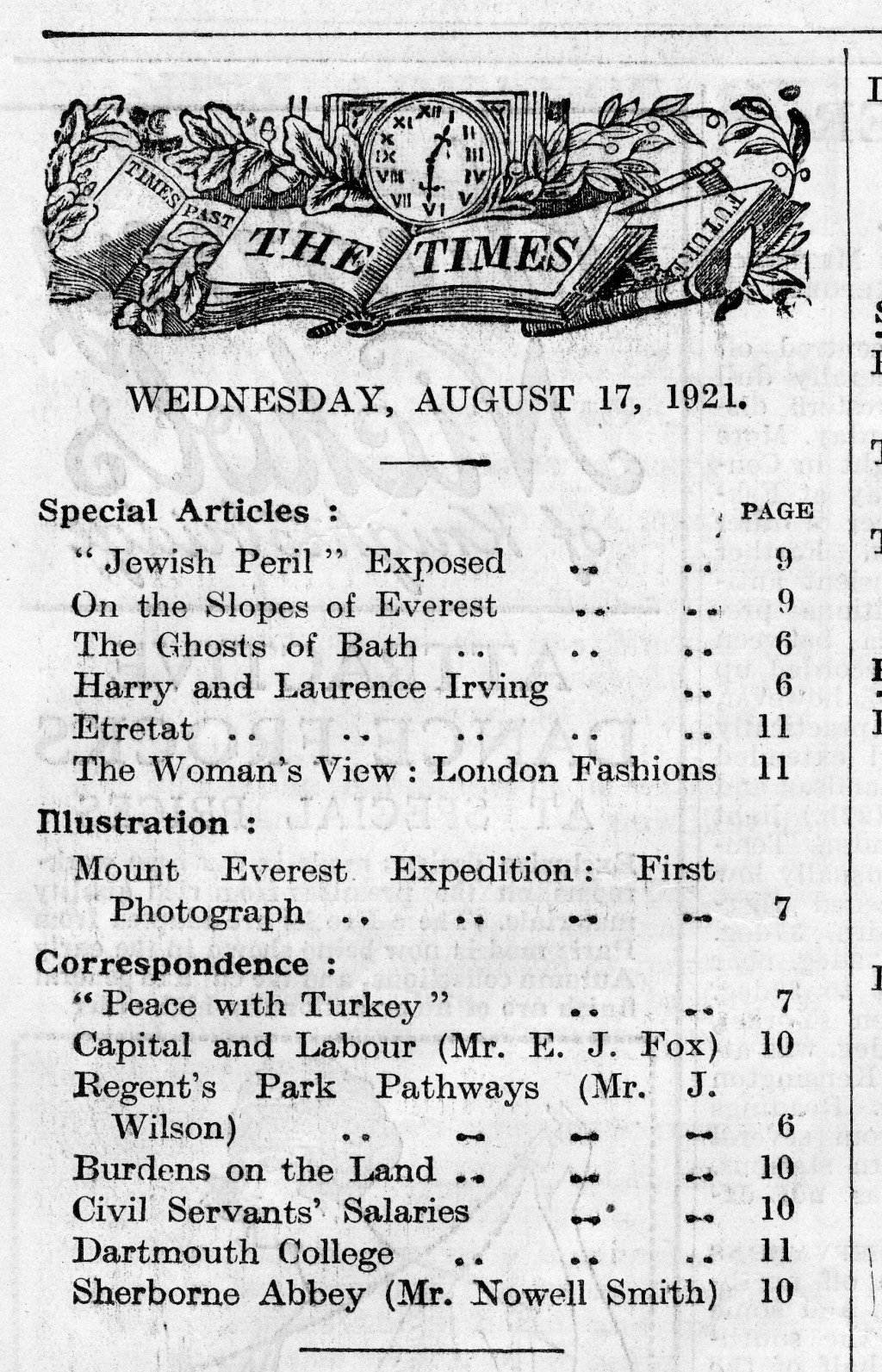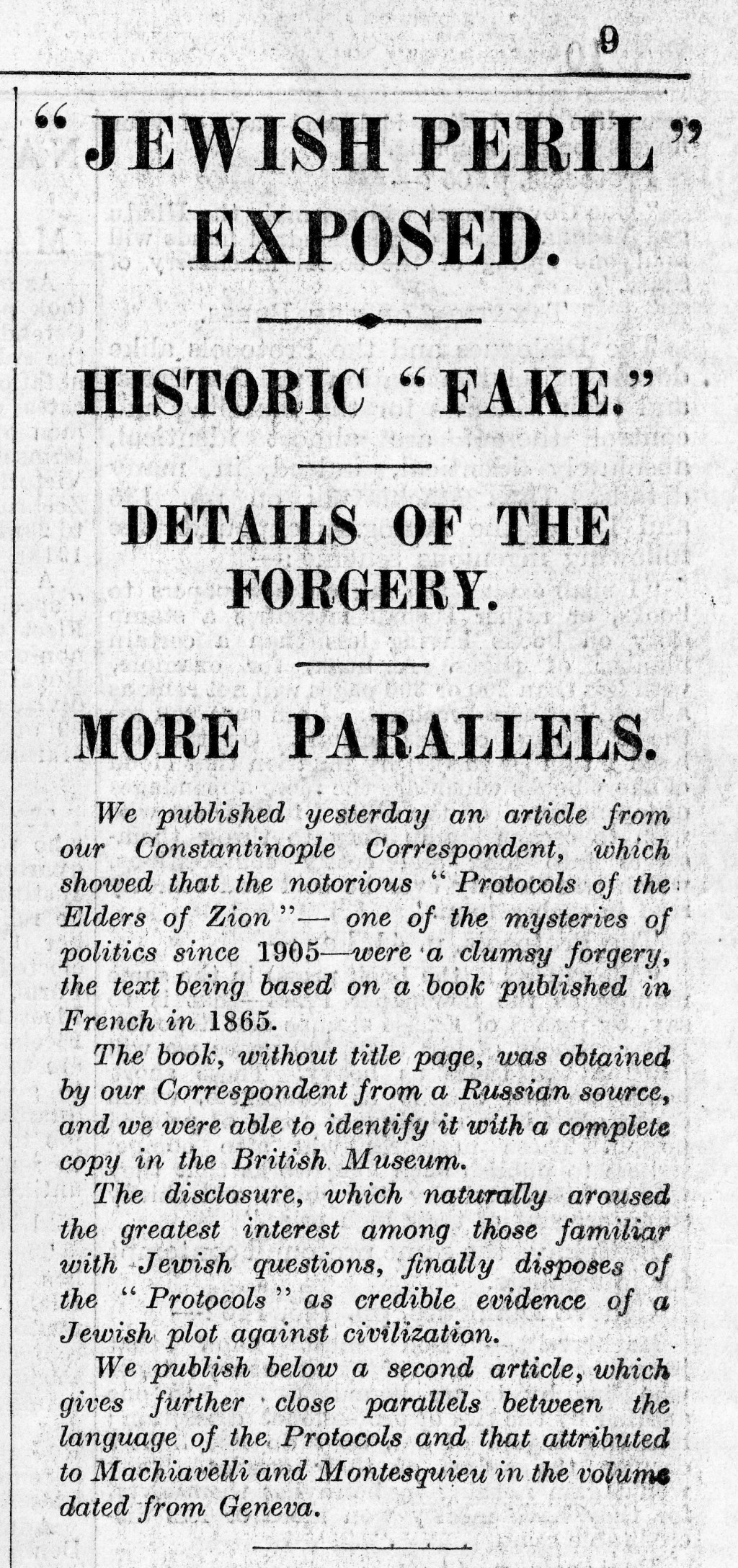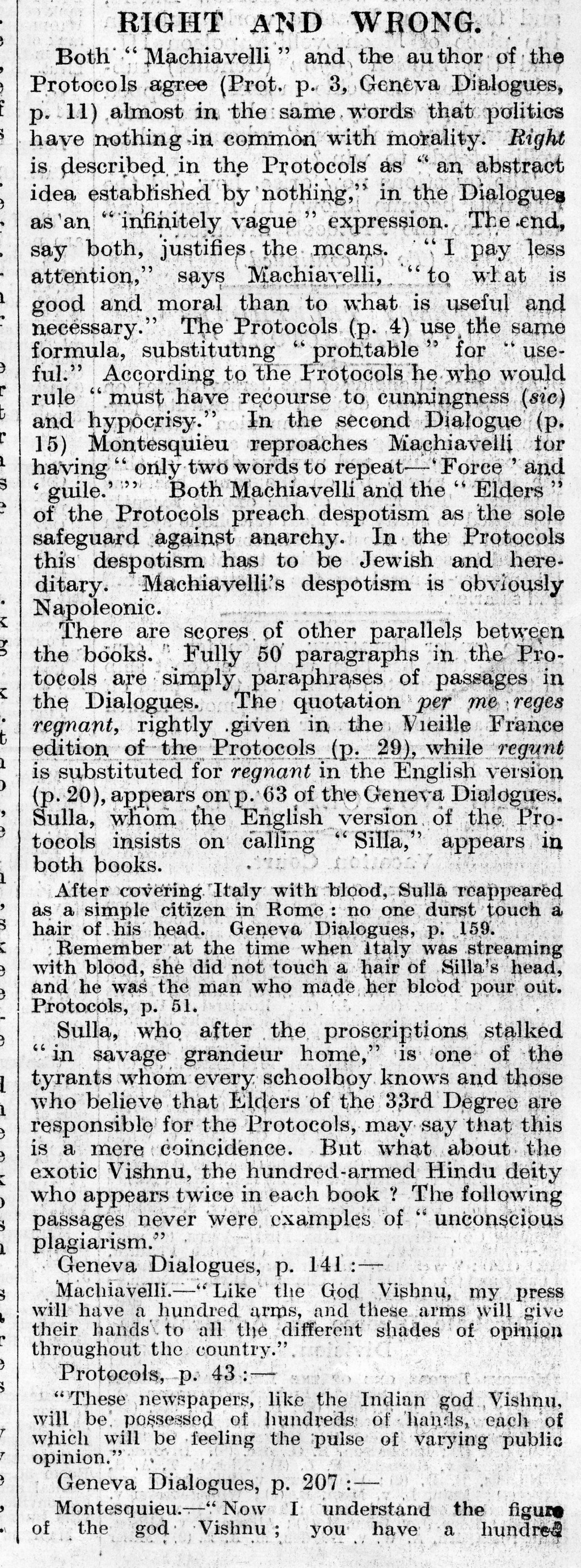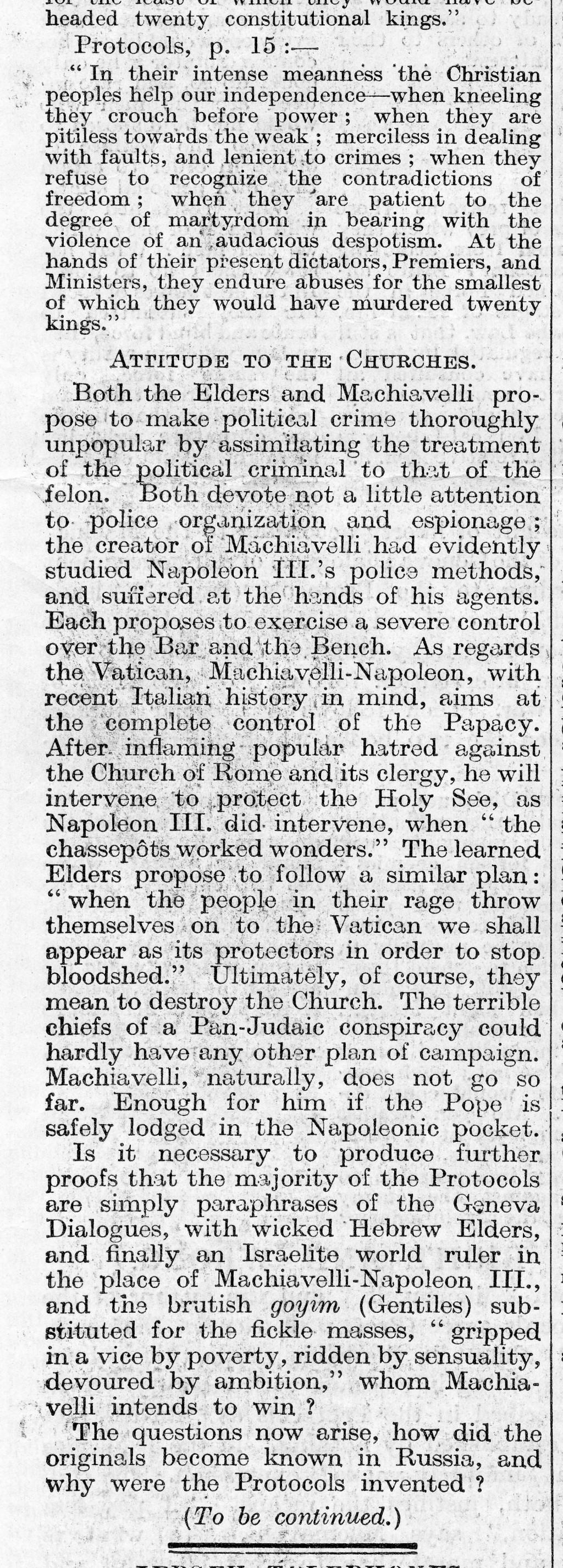
An Antisemitic Conspiracy: The Protocols of the Elders of Zion
The Protocols of the Elders of Zion is an antisemitic book used to promote hatred of Jews. It was first published in 1903. The Protocols contains conspiracy theories about alleged global Jewish power. It is the most widespread antisemitic publication of modern times.
Key Facts
-
1
The Protocols of the Elders of Zion is a publication that circulates in many languages and forms. It appears in print, on the Internet, and in other media. There are many different versions of the book. However, all of them promote antisemitic conspiracy theories about Jews.
-
2
Adolf Hitler and other top Nazi Party leaders knew that the Protocols was not factual. Despite this, they used the book to spread hatred of Jews.
-
3
The Protocols has been exposed as a lie over and over again. Nevertheless, the book remains a powerful antisemitic propaganda tool.
The Protocols of the Elders of Zion is a publication that first appeared at the beginning of the 20th century. Since then, antisemitic conspiracy theorists have used it to support the lie that a secret body of Jews controls the world. Over the decades, many editions and versions of the Protocols have been published. It continues to be published today. In recent years, the Protocols has circulated widely in multiple media, including the Internet and social media.
The Protocols was first published in a newspaper in the Russian Empire in 1903. The publisher claimed to have discovered a real document that proved there was a Jewish world conspiracy. This was not true. Journalists, courts of law, and governments have since exposed the Protocols as a fake document that promotes antisemitic lies.
Despite the fact that it is a forgery, people seeking to spread conspiracy theories about Jews have used the Protocols for more than 120 years. The Protocols is regularly adapted to address current events. Its appeal—like the appeal of conspiratorial thinking—relies on its ability to provide simple explanations to a complex world.
What is The Protocols of the Elders of Zion?
The Protocols claims to be a secret, written record of meetings supposedly held by a group called the “learned elders of Zion.” The meeting notes are fake. These meetings never took place and the purported leaders, the so-called Elders of Zion, never existed.
Early publications included 24 chapters or “protocols” (meeting minutes). Each chapter claims to document the elders’ secret plans to control world politics, the economy, financial markets, media, education, and other parts of society in order to benefit Jews. Other antisemitic lies include claims that Jews will destroy Christianity and all other world religions. The Protocols also says that Jews will profit from keeping the world in a state of war.
There are different versions or editions of the Protocols, but they are all used for one purpose: to explain the world’s problems by blaming Jews. Blaming someone else for the mistakes of others is called scapegoating. The goal for those who promote the Protocols is always to blame Jewish people for various problems in order to demonize them.
Longstanding Antisemitic Conspiracy Theories and the Protocols
Antisemitic conspiracy theories have existed for many centuries. These theories have evolved over time, using religious, economic, nationalist, and racist ideas to promote hatred of Jews. Jews have been falsely blamed for killing Jesus (deicide); fomenting wars and revolutions; and even spreading plagues and epidemics. They have been falsely accused of controlling politics and the world economy.
Antisemitism became more widespread in the 19th century. During this time, European and North American societies experienced major social, economic, and political changes. There were advancements in communications, including printing technologies. This allowed people to more quickly spread ideas across the world. One strain of antisemitism at the time claimed that Jews orchestrated all these changes for their own benefit. Such antisemitic conspiracy theories appear in many versions of the Protocols.
Though the Protocols did not invent these prejudices against Jews, it brought them together in a single source. The book reinforces the most popular antisemitic conspiracy theories and amplifies them.
The Origin of the Protocols: Where Did the Lie Begin?
The first version of The Protocols of the Elders of Zion dates to 1903. That fall, the Protocols was serialized in Znamia (The Banner), a newspaper in St. Petersburg, Russia. Znamia was owned by Pavel Krushevan. Krushevan was an accomplished writer and a ruthless antisemite. He owned multiple newspapers in the Russian Empire and used them to promote hatred of Jews. In April 1903, antisemitic articles in one of Krushevan’s newspapers helped incite a pogrom in Kishinev.
Some scholars are convinced that Krushevan was the original author of the Protocols. When his newspaper published the text, he authored a foreword and an afterword. He claimed that the Protocols was minutes from a meeting of the “World Union of Freemasons and Elders of Zion.” Krushevan accused Jews of plotting to control the world. As supposed “evidence,” he cited the emerging Zionist movement. In line with other nationalist movements at the time, Zionism advocated for an independent Jewish state in the ancient Jewish homeland. Some people have claimed that the Protocols is the meeting minutes of the First Zionist Congress, held in Basel, Switzerland, in 1897. This is not true.
In 1905, the Protocols was published as an appendix to a book about the coming of the Antichrist. This book was written by the antisemitic Russian mystic Sergei Nilus. It says that Jews are agents of satanic forces seeking to destroy the world.
The Protocols Spreads Around the World
The Protocols of the Elders of Zion began to circulate more broadly after the Bolshevik Revolution of 1917. That year, the Russian tsar abdicated his throne in the midst of a popular uprising. Demonstrators demanded food, the end of World War I, and an end to the tsar’s imperial rule. Several months later, the Bolshevik Party seized power in Russia in a coup known as the Bolshevik Revolution. The Bolshevik Party later became known as the Communist Party.
Fear of similar Communist revolutions spreading throughout Europe reinforced one of the main antisemitic conspiracy theories contained in the Protocols: that Jews were to blame for communism and for plotting this revolution. This false accusation is often referred to as “Judeo-Bolshevism.”
In the following years, the Protocols found receptive audiences in many other countries. It was translated into dozens of languages and published around the world. A German-language edition appeared in Germany in 1919. During the 1920s, versions of the Protocols surfaced across Europe and in the United States. There was a French translation in Paris, as well as English translations in London, New York, and Boston. Editions soon could be found in Japanese (1920), Italian (1921), Swedish (1921), Norwegian (1921), and Polish (1923). An Arabic translation was available in Syria by 1925.
The Protocols inspired many other books that promoted antisemitic conspiracy theories. Among the best known in the United States was Henry Ford’s The International Jew: The World’s Foremost Problem. Ford was the founder of the Ford Motor Company. He was one of the most famous and respected people in the United States by the 1920s. The International Jew was first serialized in Ford’s newspaper, The Dearborn Independent. It was quickly published as a book and translated into at least 16 languages, including German. Nazi Party leaders, among them Adolf Hitler, took inspiration from The International Jew.
As the Protocols circulated around the world, the specifics of the text often were modified to address current events and local circumstances. This is one reason why the content of the Protocols varies from edition to edition and language to language. Nevertheless, the core antisemitic ideas in all versions remain the same.
The Protocols Exposed as a Lie: 1920s
In 1920, British journalist and diplomat Lucien Wolf published a book exposing the Protocols as a lie. He found that a chapter of a German-language novel, Biarritz (1868), contained ideas that were used to fabricate the text. In this work of fiction, Jewish leaders meet secretly in the Old Jewish Cemetery in Prague. At the end of the meeting, the Devil arrives to support them.
The following year, The Times newspaper (London) declared the Protocols a “fake” and a “clumsy forgery.” The Times discovered that much of the Protocols had been copied from a little-known French political satire: Maurice Joly's Dialogue in Hell Between Machiavelli and Montesquieu (1864). There is no mention of Jews in Dialogue in Hell.
Other reports exposing the Protocols soon appeared in the United States and in Germany. New York Herald reporter Herman Bernstein published The History of a Lie: The Protocols of the Wise Men of Zion in 1921. Three years later, Benjamin Segel, a German journalist, wrote The Protocols of the Elders of Zion, Critically Illuminated (Die Protokolle der Weisen von Zion, kritisch beleuchtet). In a preface to an English edition of his book, Segel wrote:
“This forgery has caused untold misery to the Jews, and still exercises an incredible spell on the minds of the seduced masses.”
Adolf Hitler and the Protocols
During the early 1920s, Adolf Hitler was introduced to the Protocols by a leading thinker in the Nazi Party, Alfred Rosenberg. The conspiracy theories in the book reinforced Hitler’s already strong convictions that Jews were responsible for Germany’s losses in World War I.
Hitler referred to the Protocols in some of his earliest political speeches in the 1920s. He also wrote about the book in his autobiography Mein Kampf (1925). Hitler claimed that the Protocols “reveal the nature and activity of Jewish people and expose…their ultimate final aims.” He also predicted that what he called the “Jewish menace” would be “broken” after the Protocols became more widely known.
After he became chancellor of Germany in 1933, Hitler did not refer directly to the Protocols in public speeches. But he often echoed many of the book’s lies. Among them was the claim that Jews were responsible for the spread of communism. This antisemitic conspiracy theory is known as Judeo-Bolshevism.
Nazi Propaganda and the Protocols
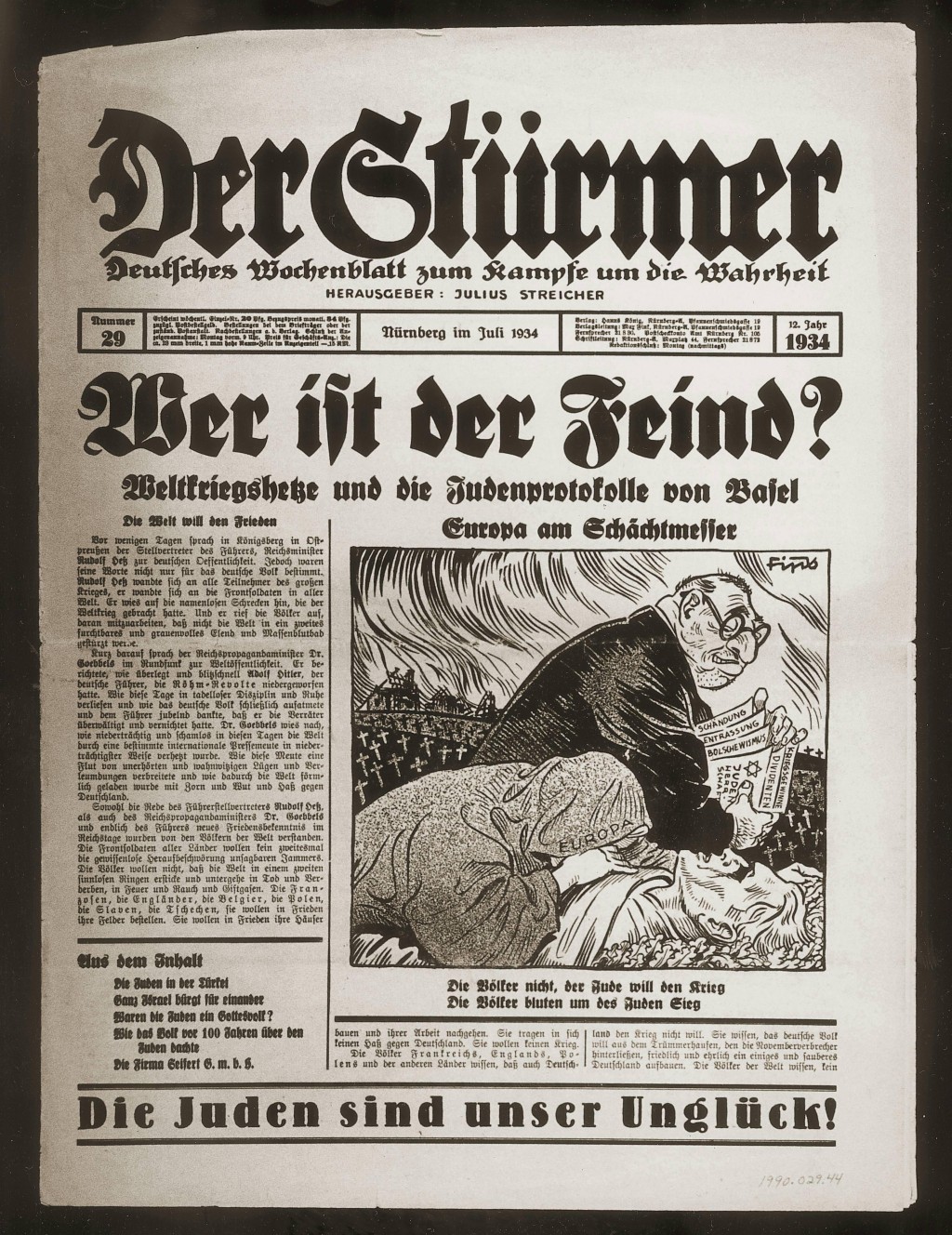
The Protocols had been exposed as a lie more than a decade before the Nazis came to power in 1933. Nevertheless, Nazi propaganda sometimes used the Protocols to rally Germans around the idea that Germany needed to defend itself from Jewish aggressors. Although most Germans likely did not read the Protocols, they would have been familiar with its antisemitic lies from relentless Nazi propaganda campaigns.
Joseph Goebbels, Nazi Germany’s Minister of Public Enlightenment and Propaganda, understood that the Protocols could be used to demonize Jews. Long before he assumed the role, Goebbels referenced the Protocols in his diary. He wrote: “I believe that The Protocols of the Elders of Zion is a forgery.” However, Goebbels continued, “I believe in the inner, but not the factual, truth of The Protocols.” For Goebbels, what mattered was that the Protocols could advance the Nazis’ antisemitic agenda.
Some of the Nazi Party’s most aggressively antisemitic propaganda made use of the Protocols. For example, Julius Streicher, publisher of the antisemitic newspaper Der Stürmer, ran many stories during the 1930s that relied on ideas included in the Protocols. The Nazi Party’s central publishing house (Franz Eher Verlag) issued 22 editions of the Protocols between 1919 and 1938.
The Protocols Exposed as a Lie: 1930s
Nazi sympathizers beyond Germany also circulated copies of the Protocols. Their actions were challenged in two court cases.
In 1934, a case was brought in Grahamstown, South Africa, against the leaders of the South African Gentile National Socialist Movement (also known as the Greyshirts). These Nazi sympathizers were sued and fined for circulating a document that resembled the Protocols. A division of the South African Supreme Court ruled that the Protocols was a “defamatory document.”
In 1935, a Swiss court fined two Nazi leaders for distributing a German-language edition of the Protocols at a demonstration by the National Front. The National Front was an extreme nationalist antisemitic organization in Bern, Switzerland. The presiding justice at the trial declared the Protocols “ridiculous nonsense.”
Nazi Editions of the Protocols during World War II
During World War II (1939–1945), Germany invaded and occupied much of Europe, including parts of the Soviet Union. The Nazis circulated the Protocols in countries they occupied. Even after millions of Jews had been murdered as part of the “Final Solution,” in 1943 German authorities published editions of the Protocols in Russian, Ukrainian, and Belarusian. Versions of the Protocols and other texts that promoted lies about Jewish conspiracies also appeared in German-occupied France, Belgium, and Poland.
The Protocols Exposed as a Lie: After the Holocaust
In 1964, a US Senate subcommittee released a report declaring that the Protocols was “a vicious hoax.” The report was written at a moment of heightened concern about communism during the Cold War. It explained that the Protocols “are one of a number of fraudulent documents that peddle the myth of an ‘international Jewish conspiracy.’” The Senate called the Protocols "gibberish."
Antisemitism, Holocaust Denial, and the Protocols Today
Exposures of The Protocols of the Elders of Zion as a lie after the Holocaust failed to lessen the book’s power. The Protocols and conspiratorial thinking about Jews continue to fuel antisemitism. Editions of the Protocols in dozens of languages are available in print and online. References to the book are often posted on social media. According to a 2024 report from the US Department of State, the Protocols retains significant influence in Russia, its country of origin.
Some newer editions of the Protocols blame Jews for the COVID-19 pandemic. They also blame Jews for war and acts of terrorism (such as the attacks on the United States on September 11, 2001). In some areas of the world, the Protocols has been included in school textbooks. It has even become the basis for television programs.
The Protocols has also been used in political propaganda and by heads of state. For example, the former president of Iran Mahmoud Ahmadinejad (2005–2013) has drawn on themes from the Protocols in his antisemitic rhetoric. Other influential political and social leaders, especially in the Middle East, have publicly claimed that the book is authentic. The Protocols has been used by the terrorist organization Hamas to justify calls for the annihilation of both Jewish people and the State of Israel.
Some recent versions of the Protocols deny that the Holocaust happened (Holocaust denial). Other editions distort the history of the Holocaust. For example, some editions falsely claim that Jews cooperated with the Nazis in order to establish the State of Israel.
The purpose of these contemporary adaptations of the Protocols continues to be the same: promoting antisemitic conspiracy theories about Jews.
Footnotes
-
Footnote reference1.
For centuries, many Christians believed that Jews committed deicide by killing Jesus. In fact, Jesus was killed by Roman authorities. The leaders of various Christian traditions reinforced this false belief in their official teachings. It was not until the late 20th century that some Christian churches condemned the charge of deicide as false. For example, the Roman Catholic Church repudiated these lies as part of the Second Vatican Council in 1965.
-
Footnote reference2.
For three days in April 1903, non-Jewish residents turned against their Jewish neighbors. They wounded hundreds of Jews and murdered more than forty. The Kishinev pogrom was preceded by antisemitic propaganda, including an accusation of blood libel. The perpetrators of the pogrom justified their actions by claiming self-defense against Jewish aggression.
-
Footnote reference3.
The Freemasons are a volunteer, fraternal organization. Its roots date back hundreds of years, perhaps as early as the 1300s. During the 20th century, both antisemites and those opposed to Freemasonry argued that Jews manipulated Masonic ideology and international connections for nefarious purposes. Some conspiracy theorists began to link Jews and Masons by charging that the lodges were in the service of the “Elders of Zion."
-
Footnote reference4.
Like the Protocols, Judeo-Bolshevism is a conspiracy theory. It draws on existing antisemitic ideas about supposed Jewish plots and has been used to incite violence against Jews.
-
Footnote reference5.
Biarritz was written by Hermann Goedsche, a postal worker and a spy for the Prussian Secret Police. He published the book under the pen name “John Retcliffe.”
Critical Thinking Questions
How could the spread of a false story like the Protocols be a warning sign for genocide?
Why do lies and conspiracy theories often exist long after they are proven false?
How can individuals, groups, and governments combat the spread of and ill effects of misinformation?
How can knowledge of the events in Germany and Europe before the Nazis came to power help citizens today respond to threats of genocide and mass atrocity in the world?


